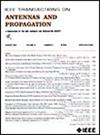Achromatic Multibeam Diffraction Based on Phase Gradient Metasurfaces
IF 5.8
1区 计算机科学
Q1 ENGINEERING, ELECTRICAL & ELECTRONIC
引用次数: 0
Abstract
Metasurfaces have attracted extensive attention due to their excellent capabilities in wavefront manipulation. However, chromatic aberration, which is widely present in phase-modulated tuning metadevices, limits their applications in modern communication systems. Far-field achromatism has been explored but only considered for single-order diffraction. With increasing demands and studies on multibeam diffraction, including, but not limited to, phase-modulated metasurfaces and metagratings, most of them are not suitable for dispersion manipulation. In this article, we analyze the achromatic mechanism of the diffraction field and propose a feasible solution to coherently control the dispersion on multiorder diffractions simultaneously. The chiral phase is introduced in the meta-atom to engineer the dispersion characteristics. In addition, an achromatic dispersion metasurface is designed for dual-beam generation as proof of concept. The two beams with propagation direction −35° and +35° show good angle stability at the targeted frequencies of 7, 10, and 13 GHz. Moreover, the limitations on beam direction accuracy and metasurface aperture are also discussed. An improvement method that can greatly enhance the accuracy of diffraction angle is further proposed, where the deviation between actual beam angles and expected ones is reduced to below 0.8°, with a 73% enhancement. The proposed work builds up a major advance for diffraction management and shows great potential in wireless communications and radar detection.基于相位梯度超表面的消色差多光束衍射
超表面由于其优异的波前处理能力而引起了广泛的关注。然而,相位调制调谐器件中普遍存在的色差问题限制了其在现代通信系统中的应用。对远场消色差进行了探讨,但只考虑了单级衍射。随着对多光束衍射的需求和研究的不断增加,包括但不限于调相超表面和超聚集,其中大多数不适合色散操作。本文分析了衍射场消色差的机理,提出了同时相干控制多阶衍射色散的可行方法。在元原子中引入手性相来设计色散特性。此外,还设计了一种消色差色散超表面,用于双光束的产生,作为概念验证。在7 GHz、10 GHz和13 GHz目标频率下,−35°和+35°传播方向的两束具有良好的角度稳定性。此外,还讨论了光束方向精度和超表面孔径的限制。进一步提出了一种改进方法,可以大大提高衍射角的精度,将实际光束角与期望光束角的偏差减小到0.8°以下,提高了73%。这项工作在衍射管理方面取得了重大进展,在无线通信和雷达探测方面显示出巨大的潜力。
本文章由计算机程序翻译,如有差异,请以英文原文为准。
求助全文
约1分钟内获得全文
求助全文
来源期刊
CiteScore
10.40
自引率
28.10%
发文量
968
审稿时长
4.7 months
期刊介绍:
IEEE Transactions on Antennas and Propagation includes theoretical and experimental advances in antennas, including design and development, and in the propagation of electromagnetic waves, including scattering, diffraction, and interaction with continuous media; and applications pertaining to antennas and propagation, such as remote sensing, applied optics, and millimeter and submillimeter wave techniques

 求助内容:
求助内容: 应助结果提醒方式:
应助结果提醒方式:


